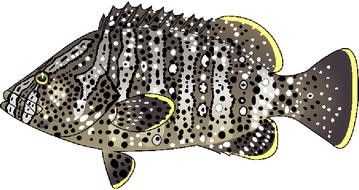Leather Bass

Species Details
Dermatolepis Dermatolepis
Serranidae
Perciformes
Onshore,Offshore, Nearshore, Reef, Wreck
7 - 28 lbs.
5" - 36"
Leather Bass (Dermatolepis dermatolepis) Fish Description
The Leather Bass (Dermatolepis dermatolepis) is a ray-finned grouper found in the eastern Pacific. It can easily be recognized through its laterally compressed body that has a distinctive color pattern of white blotches and small dark spots on a dark to light gray background. The same patchy pattern and gray color combo is also present in all its rounded fins although the fins have yellow thin bands on the edges. The dorsal fin is long that runs from where the head ends to the base of the tail fin and contains several spines and soft rays.
During spawning, Leather Bass congregate in reefs at dusk. Each female would pair off with a male and head to the surface to release their eggs and sperm into the open water from which the eggs would fertilize externally. As soon as the sperm and eggs are released, the parents would leave the fertilized eggs on their own. Juvenile Leather Bass are found living within the spines of sea urchins for protection from predators.
Diet and Size
The Leather Bass is known to be a voracious predator and eats pretty much anything it can catch, which mostly happens to be small benthic fishes; although it would sometimes also feed on small crustaceans such shrimps and crabs. And although the fish can grow a little more than three feet, most tend to be between fifteen to eighteen inches in length.
Interesting Facts
- The all-tackle world-record Leather Bass was a 28-pounder caught off the waters of Panama by angler Ricci Chavez.
- Adult Leather Bass have no known predators except for some benthic macrofauna.
- They often follow foraging grazers on reefs and eat those who have been flushed out from their hiding places.
- Though technically not a schooling fish, Leather Bass often live together in one general area as they don’t swim that far off from their home turf.
- Juveniles live within the spines of sea urchins to hide from predators.
- Leather Bass can change sex to balance out the male to the female ratio when spawning.
- Female Leather Bass tend to become much bigger than males.
- Leather Bass can live up to twenty-four years in the wild.
- Leather Bass aren’t targeted by commercial fishers but can sometimes be caught as a by-catch by commercial trawlers.
- Leather Bass is a popular fishing target by recreational anglers because of their relative abundance near the shores.
Leather Bass Fishing Tips
As Leather Bass often stay way down at the bottom of reefs and rocky underwater terrains, the best way to catch it is by treating it as if you’re targeting a grouper. A medium heavy bottom fishing tackle with a thirty to fifty-pound class reel equipped with a fifty-pound test monofilament line will do the trick. As for the bait, most successful anglers who have caught this fish used cut bait of either squid or small fish; or small live baits can be pretty effective as well.
Lastly, as soon as you feel the fish is firmly stuck to your hook, crank on your reel as hard as you can and make sure to not allow the feisty fish to swim back to its rocky lair or you will surely end up with not just a lost fish, but a snapped line as well.
Habitat and Distribution
The Leather Bass can exclusively be found in the eastern Pacific—particularly from southern California to Ecuador; as well as within the waters of the Gulf of California. The fish also prefers coral reefs and rocky bottoms between depths of sixty and one hundred and thirty feet from which they would stay for most of their life.







